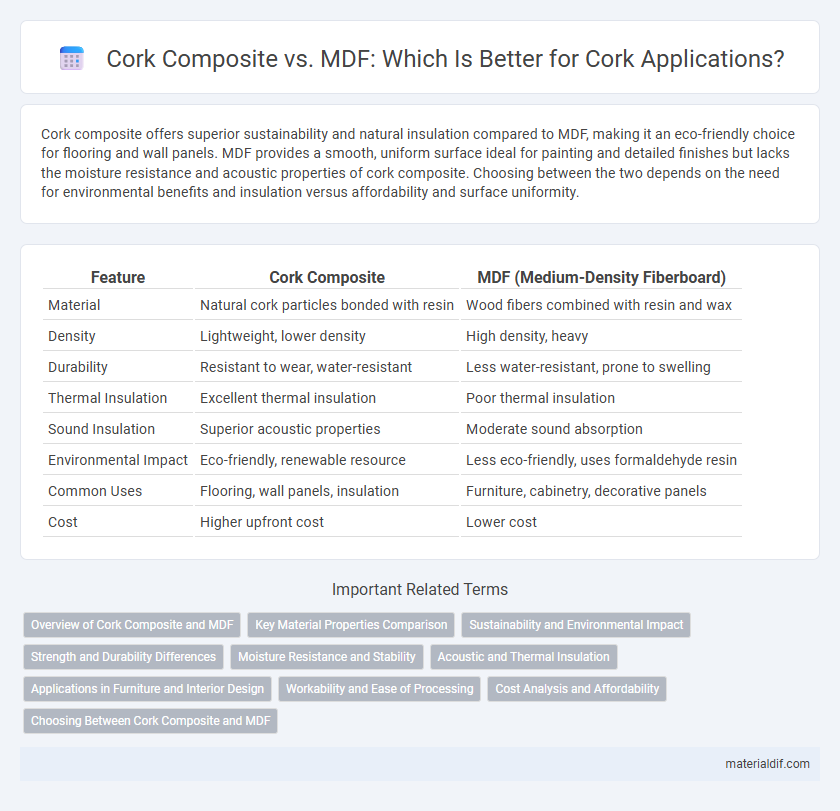Cork composite offers superior sustainability and natural insulation compared to MDF, making it an eco-friendly choice for flooring and wall panels. MDF provides a smooth, uniform surface ideal for painting and detailed finishes but lacks the moisture resistance and acoustic properties of cork composite. Choosing between the two depends on the need for environmental benefits and insulation versus affordability and surface uniformity.
Table of Comparison
| Feature | Cork Composite | MDF (Medium-Density Fiberboard) |
|---|---|---|
| Material | Natural cork particles bonded with resin | Wood fibers combined with resin and wax |
| Density | Lightweight, lower density | High density, heavy |
| Durability | Resistant to wear, water-resistant | Less water-resistant, prone to swelling |
| Thermal Insulation | Excellent thermal insulation | Poor thermal insulation |
| Sound Insulation | Superior acoustic properties | Moderate sound absorption |
| Environmental Impact | Eco-friendly, renewable resource | Less eco-friendly, uses formaldehyde resin |
| Common Uses | Flooring, wall panels, insulation | Furniture, cabinetry, decorative panels |
| Cost | Higher upfront cost | Lower cost |
Overview of Cork Composite and MDF
Cork Composite is a sustainable material made from natural cork granules bonded with resin, offering excellent insulation, durability, and moisture resistance. MDF (Medium Density Fiberboard) is an engineered wood product composed of wood fibers combined with wax and resin, known for its smooth surface, strength, and affordability. Cork Composite excels in eco-friendliness and sound absorption, while MDF is preferred for its uniformity and ease of machining in furniture and cabinetry.
Key Material Properties Comparison
Cork composite offers superior thermal insulation, durability, and water resistance compared to MDF, making it ideal for moisture-prone environments. MDF, primarily made from wood fibers and resin, tends to have higher density and smooth surface but is more susceptible to swelling and damage when exposed to water. Cork composite's natural elasticity and lightweight properties also contribute to enhanced sound absorption and environmental sustainability versus MDF.
Sustainability and Environmental Impact
Cork composite outperforms MDF in sustainability due to its renewable sourcing from cork oak trees, which regenerate bark without felling the tree, making it a carbon-negative material. MDF production relies on wood fibers and resins that often include formaldehyde-based adhesives, leading to higher emissions and environmental concerns. Cork composite's biodegradability and natural resistance to mold and pests reduce chemical treatments, significantly lowering its ecological footprint compared to MDF.
Strength and Durability Differences
Cork composite flooring offers superior resilience and natural flexibility compared to MDF, making it highly resistant to impacts and wear in Cork's variable climate. MDF, while dense and smooth, lacks the elasticity of cork composite, resulting in greater susceptibility to water damage and structural deformation over time. The inherent cellular structure of cork composite provides enhanced durability and longevity, ideal for high-traffic areas and moisture-prone environments common in Cork.
Moisture Resistance and Stability
Cork composite exhibits superior moisture resistance compared to MDF due to its natural cellular structure that repels water and prevents swelling. MDF, composed of wood fibers and resin, tends to absorb moisture, leading to dimensional instability and warping in humid environments. Cork's enhanced stability makes it an ideal choice for applications requiring durability in moisture-prone settings, such as flooring and wall insulation.
Acoustic and Thermal Insulation
Cork offers superior acoustic insulation compared to MDF due to its natural cellular structure that effectively absorbs sound waves, reducing noise transmission in interior spaces. Thermal insulation properties of cork outperform MDF, as its low thermal conductivity helps maintain consistent indoor temperatures and enhance energy efficiency. Unlike MDF, cork is eco-friendly and moisture-resistant, making it ideal for environments requiring both thermal regulation and soundproofing.
Applications in Furniture and Interior Design
Cork composite offers superior natural insulation and moisture resistance compared to MDF, making it ideal for eco-friendly furniture and sustainable interior design applications such as wall panels and flooring. MDF is preferred for its smooth surface and ease of machining, allowing detailed molding and painting in cabinetry and decorative furniture pieces. Both materials contribute unique aesthetic and functional benefits, with cork enhancing warmth and acoustic properties while MDF supports intricate design versatility.
Workability and Ease of Processing
Cork composite offers superior workability compared to MDF due to its natural flexibility and lightweight properties, making it easier to cut, shape, and sand without significant dust production. MDF's denser structure requires specialized tools for precise cutting and poses challenges in handling due to dust emission and material fragility. Cork's resilience and moisture resistance enhance ease of processing in applications needing durability, whereas MDF demands careful sealing to prevent swelling and degradation.
Cost Analysis and Affordability
Cork composite offers a cost-effective solution by combining natural cork with synthetic materials, resulting in enhanced durability at a moderate price point compared to MDF. MDF, or Medium-Density Fiberboard, generally has a lower initial cost but may incur higher maintenance and replacement expenses over time due to its susceptibility to moisture and damage. Considering long-term affordability, cork composite surfaces in Cork provide superior value through increased lifespan and reduced upkeep costs.
Choosing Between Cork Composite and MDF
Choosing between cork composite and MDF depends on factors like durability, environmental impact, and application. Cork composite offers superior natural insulation, moisture resistance, and sustainability due to its renewable cork fibers. MDF provides a smooth surface ideal for painting and shaping but lacks the eco-friendly benefits and water-resistant properties found in cork composite.
Cork Composite vs MDF Infographic

 materialdif.com
materialdif.com